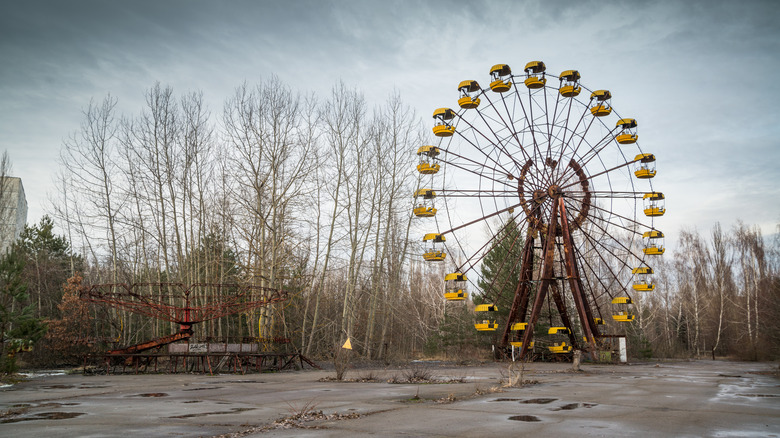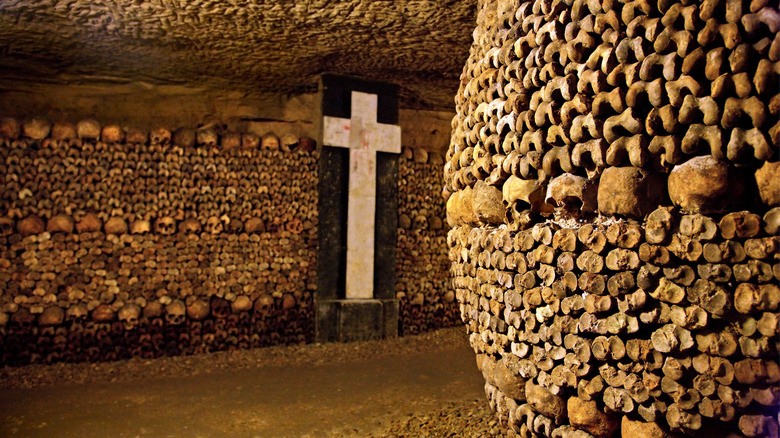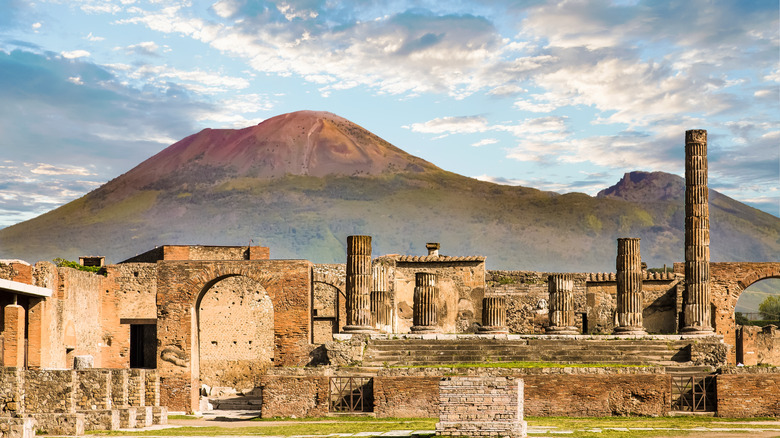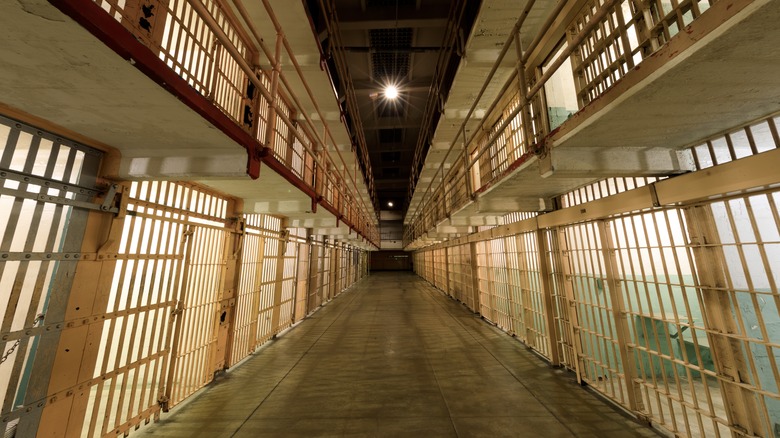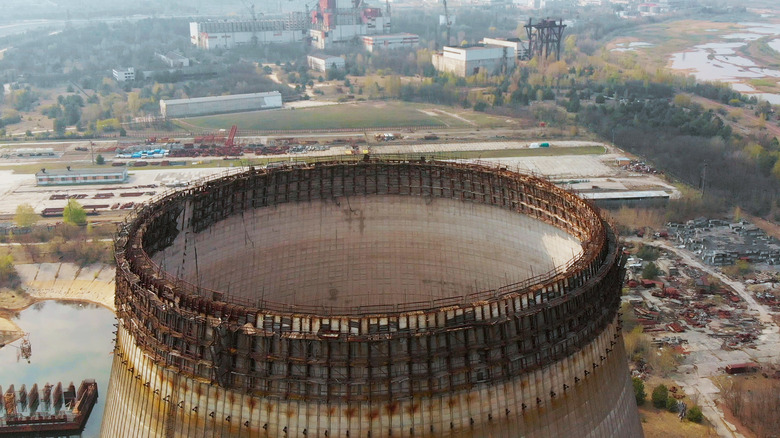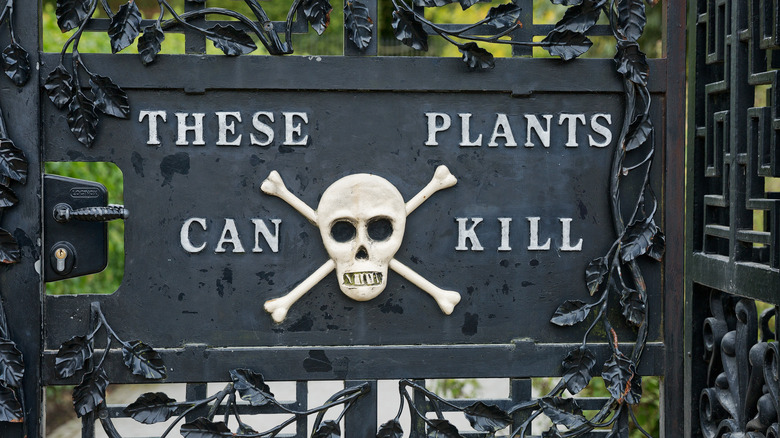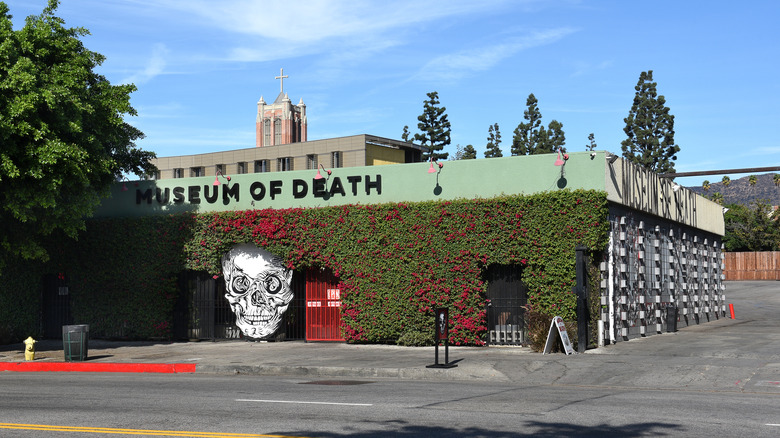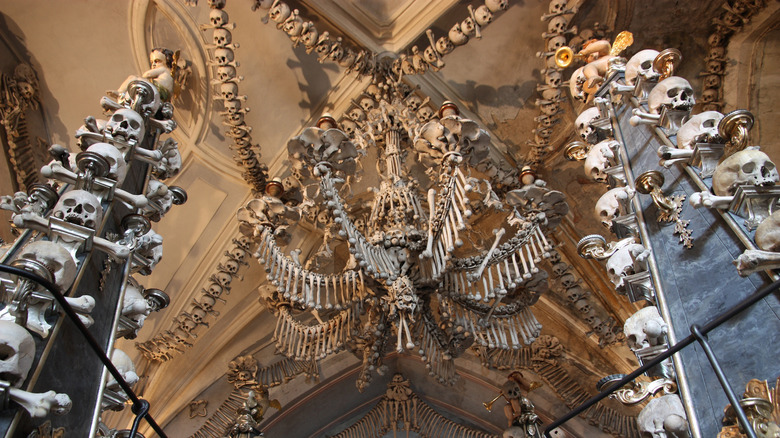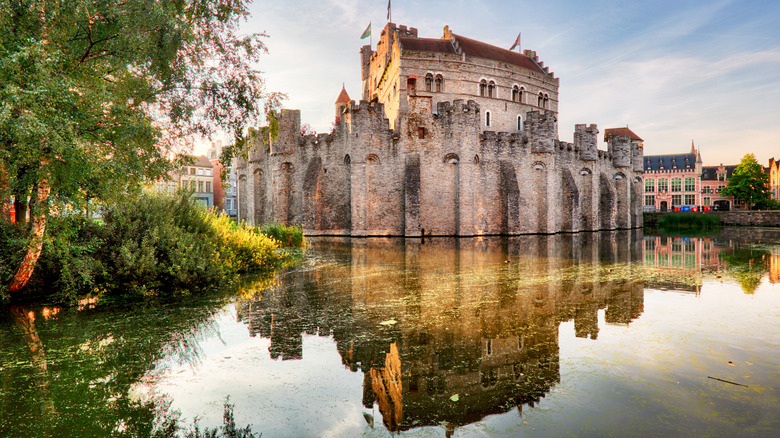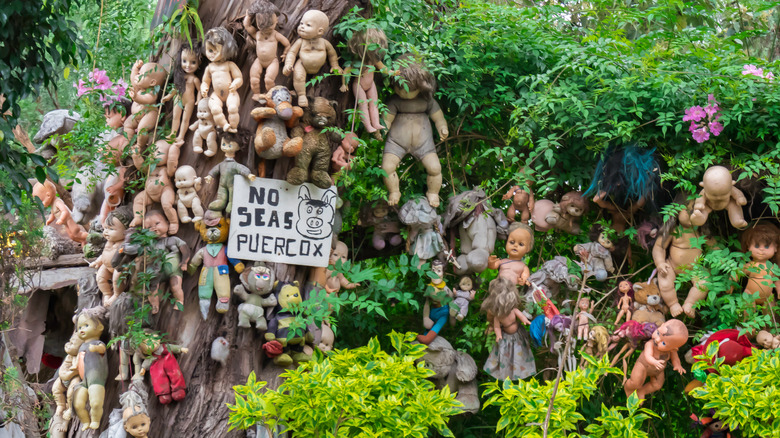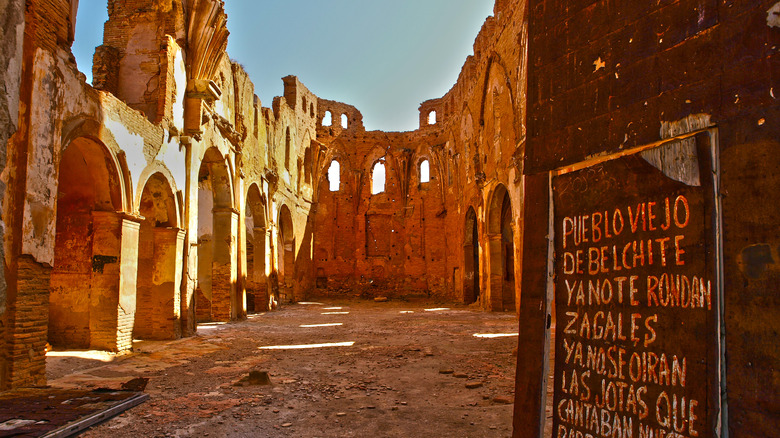11 Unnerving Dark Tourism Destinations Around The World
Most people plan their vacation to be the most rejuvenating, relaxing experience of the whole year, but there are a select few who travel the world in the hopes of finding the most disturbing attractions. Ever since the release of the 2018 hit TV show "Dark Tourist," the public has become more aware of and intrigued by the slightly more morbid destinations around the globe. This fascination and hobby is called dark tourism.
According to one survey from Passport Photo Online, 82% of American travelers said they had visited at least one dark tourism destination in their life so far. Most of these dark tourism travelers stated that they visit these types of creepy or depressing places because it allows them to educate themselves and pay respects to people affected by tragedies. Whether they're sad or even borderline scary, the thing that dark tourist destinations usually have in common is that they showcase a realistic, yet sometimes unpleasant, peek into the world's history firsthand.
The Catacombs of Paris
One of the oldest and most famous dark tourism destinations in the world is the Catacombs of Paris. The Catacombs are a deep series of tunnels that were converted into ossuaries as a solution to the overflow of dead bodies filling up Paris' cemeteries and creating a public health crisis in the 18th century. The remains of somewhere between 6 to 7 million people were carefully placed inside the Catacombs and still remain to this day.
Though the deep underground tunnels are very eerie, the Catacombs have been open as a tourist attraction to the public for over two centuries. There are over 200 miles of tunnels in the Catacombs, but most of it is unexplored by regular tourists and only certain portions can be visited on organized tours. Travelers are welcome to join a 1.25-mile walk through this mass underground burial site and its dark history.
Pompeii
The story of Pompeii is one that sticks with a lot of people after a trip to Italy. This Italian city was thriving 2,000 years ago when all of a sudden one day Mount Vesuvius erupted unexpectedly and completely took everyone in the area out. Toxic gas and smoke were carried from the explosion for 20 miles. The citizens' lives were frozen forever under ash until the city was discovered again in 1748.
It was a chilling part of history that really showed how instantaneously life can change. Today, the city of Pompeii is one of the most popular tourist attractions in Italy, but nobody forgets its grisly backstory. There are even casts of the bodies curled up in fear to really hit home the terror of this natural disaster. Travelers visiting Pompeii should opt to join a tour or at least invest in an audioguide to get all the information about the city and the influence of its tragedy.
Alcatraz Island
Most people wouldn't put a prison on their vacation wishlist, but Alcatraz in San Francisco is different. Every single year over 1.4 million people make the journey to visit Alcatraz Island. Dubbed "The Rock," it was open from 1934 to 1963 as a maximum security, inescapable prison right in the middle of San Francisco Bay.
Famous criminals like Al Capone, James "Whitey" Bulger, and George "Machine Gun" Kelly were housed in this hardcore prison for years. Capone even played the banjo in a literal band of inmates during his time at Alcatraz. There is an immense amount of weird, criminal history inside the walls of this famous prison.
Even though it closed its doors as a jail 60 years ago, Alcatraz is still open for the tourism business to this day. There are regular tours to Alcatraz from Pier 33 and it only takes around 20 minutes to reach the island by boat. Just make sure you book your ticket in advance as there is limited availability and visiting Alcatraz is one of the most popular things to do in San Francisco.
Chernobyl Exclusion Zone
In 1986, a deadly catastrophe changed Ukraine and the world forever. A reactor at a huge power plant malfunctioned and it caused a massive steam explosion, creating fires that released the radioactive material in the power plant's core to the nearby area. The results were so toxic that 350,000 people were evacuated.
The effects of Chernobyl (Chornobyl in Ukrainian) were absolutely devastating with two workers dying from the blast, 28 passing away from radiation within weeks of the incident, and 5,000 people who would get cancer over the following years. The event would go on to be called the Chernobyl Incident and it became known around the globe for just how horrible it was.
The Chernobyl incident in Ukraine was by far the worst nuclear disaster in history. It's been long enough since the incident that the area isn't completely toxic anymore and curious dark tourism travelers can visit the Chernobyl Exclusion Zone. Chernobyl is still so dangerous that visitors must be accompanied by a trained guide with radiation monitoring equipment to make sure they don't wander anywhere that's too toxic. Note that currently, tours to Chernobyl are paused for the foreseeable future due to the Russian invasion of Ukraine.
The Poison Garden
Most people add a picturesque botanical garden to their travel itinerary for a relaxing afternoon among the greenery, but Alnwick Garden in Northumberland, England has an area where everything could harm you. The Poison Garden is under lock and key at the Alnwick Garden for good reason: Even a sniff can have devastating effects on the human body.
There are about 100 highly toxic species of plants living inside the Poison Garden right now, including the opium poppy, monkshood (wolfsbane), helleborus odorus (fragrant hellebore), and atropa belladona (deadly nightshade), among many, many others. And despite the danger of the dangerous flora, brave visitors are welcome to walk through if they dare. But be aware. According to Alnwick Garden, visitors are cautioned against interacting with any of the plants, and some people have even passed out just from walking through the garden. Enter at your own risk.
Museum of Death
Travelers are always keen to find the best art and history museums in a city, but the Museum of Death is a much darker sort of attraction. There is a Los Angeles and a New Orleans version of this museum. Established in 1995, the Museum of Death covers the disturbing side of history. The displays are so extreme that families with kids should definitely skip this potentially traumatizing museum.
Inside each location of the Museum of Death, there is an eclectic collection of disturbing artifacts related to murder and death. The Los Angeles museum includes things like art pieces handmade by serial killers, crime scene photos from the Black Dahlia and Manson family murders, body bags, replicas of execution devices, ancient mortician devices, and a real cult recruiting video. The New Orleans iteration includes stuff like letters from infamous killers, eerie crime memorabilia, shrunken heads, and displays about cannibalism. Just make sure you visit on an empty stomach because some of the displays are really messed up and may catch you off guard.
Sedlec Ossuary
It may be pretty unsettling to walk around a chapel constructed of 40,000 human bones, but that's exactly what you're in for when you visit the Sedlec Ossuary in the Czech Republic. This small, countryside Catholic church was originally built back in the 13th century, but it didn't get its unique design update until 1870 when a local woodcarver was given the job to embellish the church with bones from the cemetery and create the disconcerting masterpiece it is today.
Even though it's quite macabre, the Sedlec Ossuary is considered to be a very holy place in the Czech Republic. Inside you can find a chandelier, a family's coat of arms, and religious displays completely made out of bones. The artist who assembled many of the pieces within the Sedlec Ossuary even signed his name using bones. Don't let the creepy factor scare you away from exploring this key historical site in the region.
Gravensteen
Gravensteen, also known as the Castle of the Counts, is a spooky, impervious-looking fortress in Belgium with a very gruesome past. Though it started off as a residence for a medieval ruling royal family, it was eventually converted into a military base, court, and prison for their ruling government. Needless to say, the justice system was not as clean-cut as it is today and things got horrifically messy for people unfortunate enough to get stuck here.
Countless prisoners were tortured in unthinkable ways at Gravensteen and many of the people kept here weren't even criminals; they just had mental health conditions. In the dungeon of the castle, gory Middle Ages torture tactics were used, like the rack and others. These days, visitors are allowed to wander Gravensteen without the threat of execution. There is even a torture museum that comes with your entry ticket to the castle where travelers can get a glimpse at Gravensteen's collection of brutal torture equipment.
Island of the Dolls
As Guinness World Records explains, according to local lore, a man named Don Julian Santana Barrera was living by the canal in Xochimilco, Mexico when he started hearing the voice of a little ghost girl who had drowned in the nearby water. He'd heard her crying for a doll and near the place she drowned, he found a doll, so he hung it up in a tree and that was the start of something that remained. Don Julian became fixated on putting up dolls for the girl and soon it became known as the Island of the Dolls.
To this day the island is still covered in this ominous collection of countless dolls hanging from everywhere and taking over the area. It is actually the largest collection of haunted dolls in the world, according to Guinness World Records. Getting to the island is no walk in the park either as you have to ride down the canal in a trajinera boat to reach the dark tourism destination. The Island of the Dolls is by far one of the creepiest attractions in the world, but plenty of people still go to see the nightmarish display.
Belchite
Everyone learns about the horrors of war as they're growing up, but rarely do people get the opportunity to see such a gleaming example of its destruction as the Belchite ruins. The ruins are about 40 minutes outside of Zaragoza, Spain and it isn't just a simple museum or historic site — it's an entire ghost town that was destroyed in the Spanish Civil War and stands today as a sort of memorial of what happened there. It was destroyed by bombs in the Battle of Belchite in 1937 and the town has literally been left to decompose on its own ever since.
The remains of Belchite can still be explored to this day and it has actually become a fairly popular day trip from Zaragoza in recent years. There are few other visitable places left where you can so clearly see the impacts of war, even after nearly a whole century. There are lots of guided tours to Belchite for travelers who want this illuminating glimpse into European history. It's a really moving, thought-provoking destination, even if it's a little disturbing.
